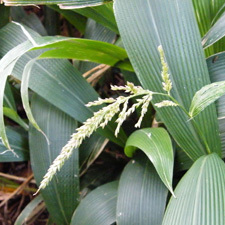 Palm grass
Palm grass
Common name: Palm grass
Botanical name: Setaria palmifolia
Management category: Sustained control - Rule 5a applies
Originally from India. It was introduced into New Zealand for ornamental purposes and was recorded as naturalised in 1981.
Why is it a pest?
- It has tough rhizomes and is long-lived and tolerant to a wide range of conditions.
- Prevents the growth and establishment of native seedlings.
- Spreads via rhizomes and seed, occasionally aided by water movement. Slower spread occurs from gardens and through dumped garden waste.
Where is it found?
Disturbed and open forest, shrubland, herbland, bareland, semi-epiphyte niches mainly in low-frost areas.
What does it look like?
- Dense, palm like grass with a dense root mass and tough rhizomes with rounded stems.
- Harsh hanging palm-like leaves are pleated and taper to a point.
- Narrow seedheads with fuzzy, foxtail-like tips on long arching stems (December to March).
What are the rules?
Sustained control
Sustained Control pests are well established in the region and preventing the spread is no longer a realistic objective. Management focuses on reducing general impacts of the pest. Landowners/occupiers are responsible for the control of these pest species on their land. Council may enforce control.
Under rule 5a of the RPMP landowners/occupiers must destroy this pest if required by a written direction from an authorised person unless a property specific pest management agreement has been agreed and signed between the occupier and the Council.
Criteria to meet Rule 5A include when the species is being actively managed by council, other agency and or community group, on an adjacent property. See the Regional Pest Management Plan 2020-2030 rules for Sustained control pests for more information.
How do you get rid of it?
- Dig-out small patches (all year) – dispose by incineration or at transfer station.
- Foliar spray (spring to autumn).
Also, an option to stem inject with herbicide.
CAUTION: When using any herbicide or pesticide, PLEASE READ THE LABEL THOROUGHLY to ensure that all instructions and directions for the purchase, use and storage of the product, are followed and adhered to.
Read more on pest control advice, information and regulations.
Images






